Physical Address
304 North Cardinal St.
Dorchester Center, MA 02124
Around 85% of 12- to 24-year olds are affected by acne, while many patients continue to struggle with acne even into adulthood.
Acne is extremely frustrating for patients and causes depression and anxiety, poor self image, as well as, lasting physical scarring.
Many patients struggle to achieve long lasting results with standard acne therapy which makes lasers and lights an important modality to consider when treating a patient refractory to treatment.
Lasers and light-based devices have the ability to not only treat acne in a more expedited manner but also to simultaneously improve acne scars.
Affecting up to 50 million Americans annually, acne is the most common skin condition in the United States. Eight five percent of those aged 12–24 are affected by acne and it in can continue well into adulthood. Lasers and light devices offer many benefits over traditional acne therapy including fewer adverse effects compared to topical and systemic therapies, decreased risk for antibiotic resistance, faster onset of action, minimizing scaring as well as decreased need for continuous therapy ( Table 14.1 ).
| Laser | Wavelength |
| Blue light | 415 nm |
| Red light | 630 nm |
| Pulsed-dye laser (PDL) | 585–595 nm |
| Intense-pulsed light (IPL) | 500–1200 nm |
| Potassium titanyl phosphate (KTP) | 532 nm |
| Nd:YAG | 1064 nm |
| Nd:YAG | 1320 nm |
| Erbium glass | 1540 nm |
| Erbium glass | 1550 nm |
| Other | 1726 nm |
Laser and light sources for treatment of acne fall into two broad categories, those that destroy Cutibacterium acnes which include: blue light, red light, green light laser, yellow light laser, and intense-pulsed light (IPL) and the second category which include devices that directly destroy sebaceous glands (infrared lasers). We discuss the rationale for using various laser- and light-based devices and their role in treating acne as well as which devices prove to be the most helpful clinically. Further, we detail the use of sequential lasers and lights to activate aminolevulinic acid (ALA) in photodynamic therapy.
Historically, the use of light in treatment of acne dates back to the 1940s. Different types of ultraviolet lights have been used to destroy follicular bacteria and expedite resolution of acne lesions. No longer are carcinogenic UVB and UVA light sources used for the treatment of acne, rather, a safer range of light delivery systems are now used. Every living cell synthesizes protoporphyrins, including protoporphyrin IX (PpIX) from endogenous ALA. When ALA is administered exogenously, premalignant and malignant cells, as well as, blood vessels and sebaceous glands, produce increasing amounts of photoactive porphyrins, including PpIX.
Photodynamic therapy requires light, a photosensitizer, and oxygen. ALA is the first compound synthesized in the porphyrin-heme pathway and is converted endogenously into the photosensitizer PpIX. Application of topical ALA bypasses the rate limiting enzyme in heme formation, ALA synthase, creating accumulation of PpIX in target tissue due to increased activity of porphobilinogen deaminase and decreased activity of ferrochelatase ( Fig. 14.1 ). Upon exposure to its visible light action spectra (400–410 nm and 635 nm), PpIX is oxidized and produces reactive oxygen species which destroy the target cell ( Fig. 14.2 ). C. acnes produces endogenous porphyrins, including PpIX and coprophorphyrin III, which makes it an excellent target for treatment with photodynamic therapy (PDT).
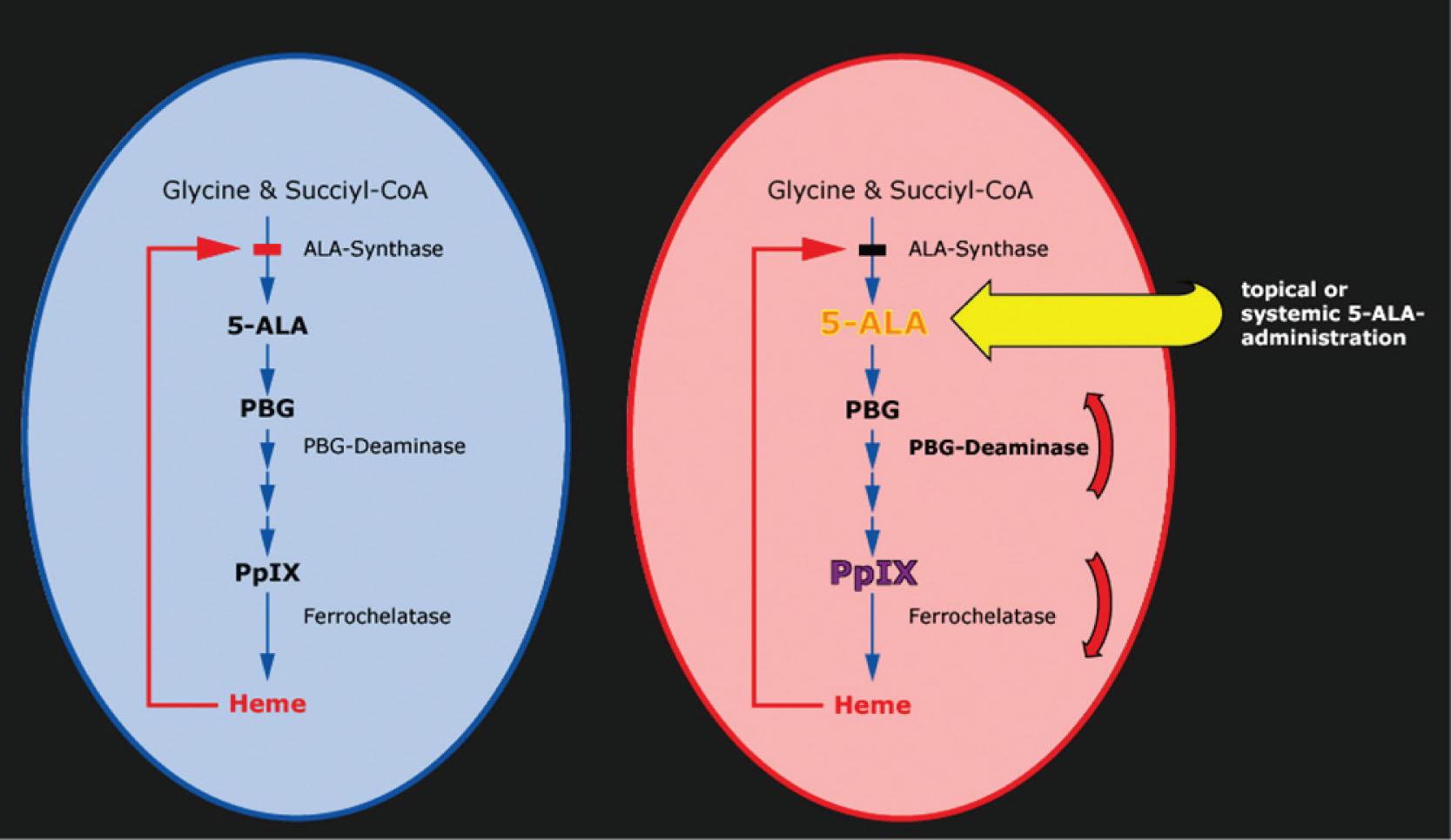
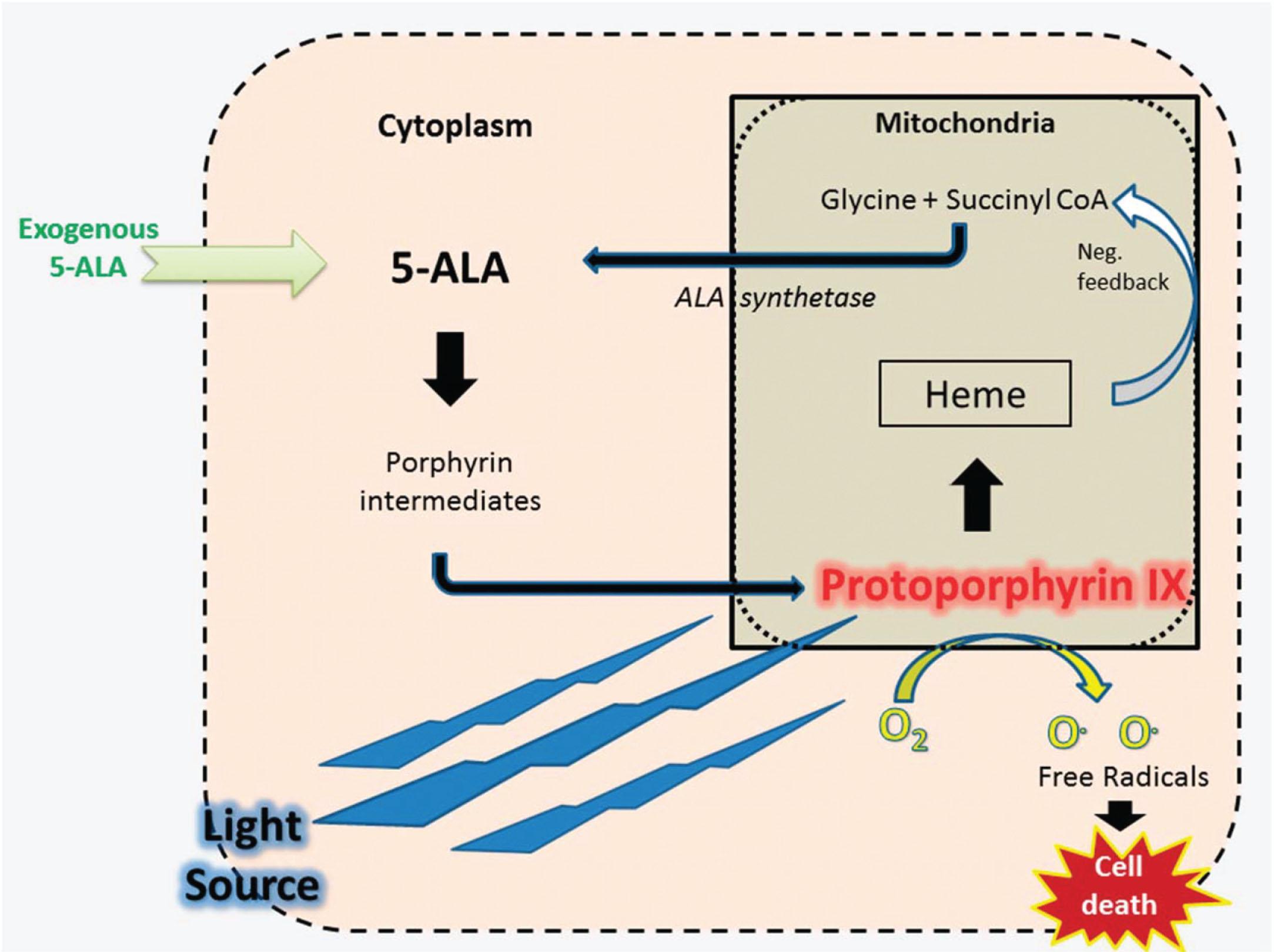
5-Aminolevulinic acid (5-ALA) is the most commonly used photosensitizer with methyl aminolevulinate (MAL), the most common derivative of 5-ALA. 5-ALA has a low-molecular weight allowing it to easily penetrate the stratum corneum. Topical ALA is available in the United States as a 20% solution and is marketed under the trade name Levulan Kerastick (DUSA Pharmaceuticals, Inc., Wilmington, MA). It is FDA approved since 1999 for the treatment of nonhyperkeratotic actinic keratosis (AKs) on the face, scalp, or upper extremities in conjunction with a blue light source. ALA in a 10% gel formulation is designed to be used with red light and is marketed under the name Ameluz (Ameluz; Biofrontera, Inc., Wakefield, MA). The gel formulation offers the advantage of enhancing skin penetration via nanoemulsion technology, longer shelf life (up to 12 weeks in the refrigerator) and the ability to illuminate the treatment area after 3 hours of application. The 20% solution must be discarded 2 hours after mixing ALA with the vehicle.
The addition of a methyl ester group makes MAL more lipophilic and enhances penetration but must be demethylated back to ALA by intracellular enzymes. MAL is no longer available in the United States; however, it is widely used in Europe. It was available in the United States as a 16.8% cream and marketed under the trade name Metvixia (Galderma Laboratories, L.P., Ft. Worth, TX).
Patients with history of photosensitizing disorders, porphyrias, or documented allergy to ALA should not be treated with PDT. Since wavelengths in the visible light spectrum are used for activation, concurrent use of photosensitizing medications should not be a concern. Degreasing the skin prior to application of ALA allows for even distribution. Traditionally, acetone was used; however, due to its low flash point and pain associated with eroded skin alternative methods are used. Peikert and colleagues showed equal degreasing capability between acetone and hibiclens for prepping skin before chemical peeling of the scalp. Isopropyl alcohol, soap, alpha-hydroxy/salicylic acid cleansers, or cleansing towelettes can also be used.
After degreasing the skin, numerous techniques can be used to disrupt the stratum corneum to increase penetration of ALA. Heavy-handed abrasion with a 4 × 4 gauze is one of the simplest and cost-effective methods of increasing ALA uptake into the skin. Lee et al. demonstrated a 40- to 50-fold increased uptake of ALA using a microabrasion device (Pepita-C, Mattioli Engineering, Florence, Italy). This device sprays aluminum oxide crystals via a nozzle with a variably programmed pressure (15–25 cm Hg), producing an abrasive effect on the stratum corneum. Similarly Zhou and Banga demonstrated increased penetration of nicotinamide, a hydrophilic molecule, using microdermabrasion with 15 in Hg aluminum oxide crystals on hairless rats (Microclear Vortx System, Lasermax services, Inc., Atlanta, GA). Increased penetration was not seen with lipophilic molecules. Pretreating the skin with microneedling prior to application of ALA has also been shown to increase penetration of ALA without increasing pain and erythema. In the authors practice, we find a non-particulate stainless steel vibratory paddle to be an efficient method of removing the stratum corneum in preparation for applying topical ALA (Vibraderm, Esthetica Inc, Allentown, PA).
Different lasers and lights can be used to activate porphyrins in PDT. Blue and red lights, as well as, IPL (500–1200 nm) and pulsed-dye laser (PDL) (585–595 nm) target the absorption peaks of PpIX. The major absorption peak of PpIX is 415 nm, otherwise known as the soret band, which lies within the blue range of the visible light spectrum ( Fig. 14.3 ). A second peak at 630 nm exists within the red range. There are also smaller absorption peaks at 505 , 540 , and 580 nm. IPL has the benefit of targeting blood vessel, pigment, and even collagen. PDL primarily targets oxyhemoglobin which makes it effective for targeting individual erythematous inflammatory lesions.
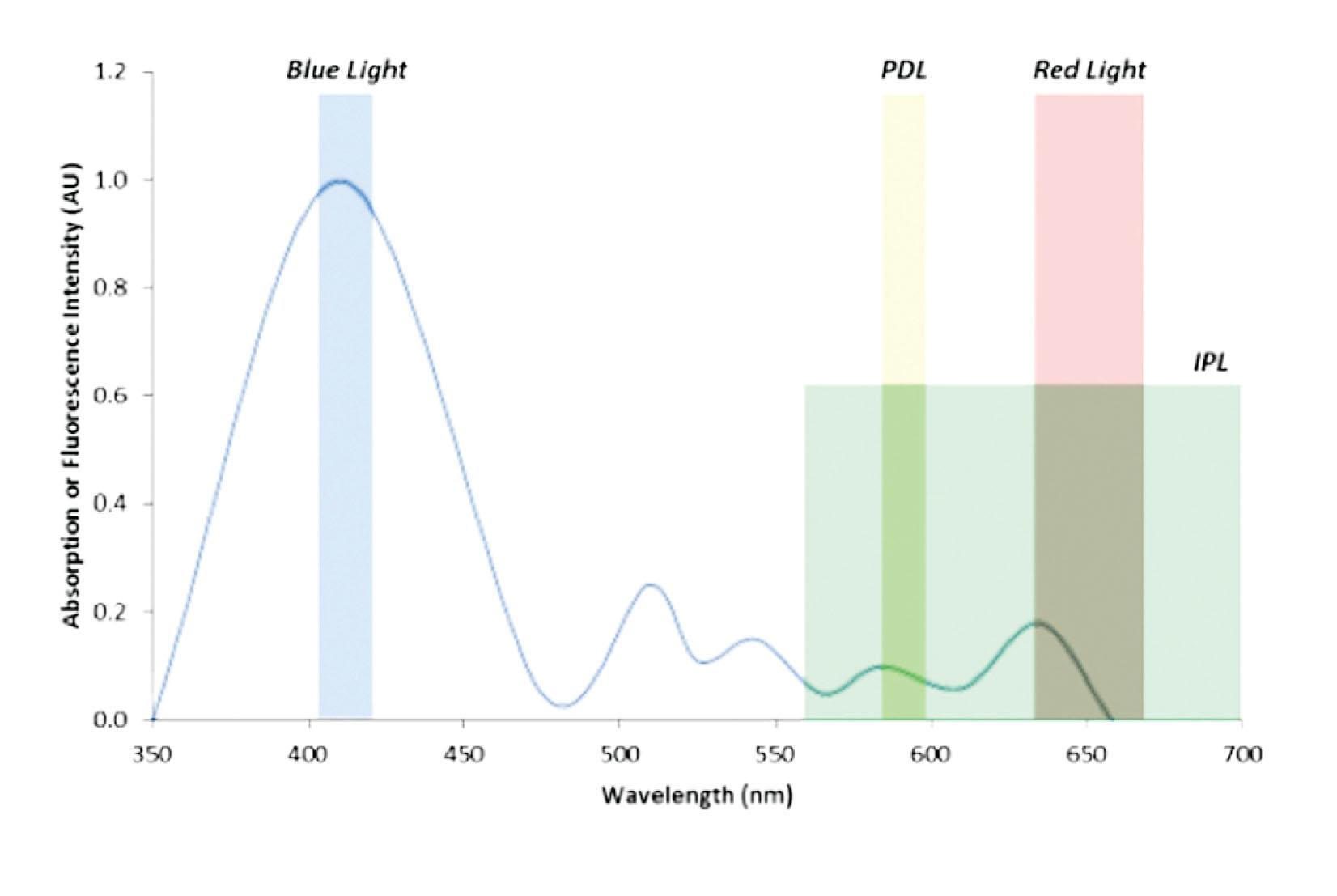
In 2000, Hongcharu et al. published the first clinical trial using ALA for the treatment of acne vulgaris. Twenty-two subjects received four different types of treatment (20% ALA plus red light, ALA alone, red light alone, and untreated control). Subjects were divided randomly into two groups, groups received either a single treatment or four treatments of Levulan Kerastick applied under occlusion for 3 hours followed by broadband (550–700 nm) light to a total fluence of 150 J/cm 2 . Only the group treated with ALA plus red light demonstrated statistically significant improvement in acne and those treated with 4 weekly treatments experienced greater improvement than those receiving a single treatment. Biopsies demonstrated reduction in the size of sebaceous glands in both the single and multitreatment groups. In the multitreatment group, continued improvement occurred with complete destruction of sebaceous gland noted at 20 weeks posttreatment. Bacterial fluorescence was also diminished.
Many studies have been conducted since the first clinical trial conducted by Hongcharu et al. Gold et al. performed a study in 2003 in patients with moderate to severe acne in which ALA was applied to patients and allowed to incubate for 30–60 minutes with high intensity blue light applied once a week for 3 months. Results showed 60% improvement in those treated with ALA and blue light (compared with 43% improvement with blue light alone). Goldman and Boyce used ALA and blue light in the treatment of mild to moderate acne. Greater improvement was seen in those treatment with ALA and blue light compared with blue light alone.
Gold et al. published another study in 2004, in which ALA was incubated for 1 hour followed by activation with IPL (430–1100 nm, pulse duration 35 milliseconds, fluence 3–9 J/cm 2 ) once weekly for four consecutive weeks. Treatments were well tolerated and on average patients achieved 72% reduction in acne lesions 12 weeks after the final treatment. Rojanamatin and Choawawanich treated 14 patients with 20% ALA solution applied under occlusion for 30 minutes followed by IPL on one half of the face versus the other half of the face was treated with IPL alone. The ALA-pretreated side demonstrated 87.7% reduction in lesion counts 12 weeks after treatment versus 67% on the side treated with IPL alone (Quantum SR, ESC Medical Systems Ltd., now Lumenis, Yokneam, Israel) settings included a cutoff filter of 560–590 nm with total fluence between 25 and 30 J/cm 2 , in double-pulse mode (first pulse between 2.4 and 3.6 milliseconds; second pulse between 4 and 6 milliseconds) with delayed time of 20–40 milliseconds.
Alexiades-Armenakas demonstrated 100% clearance of acne lesions in the PDT activated by long-pulsed PDL (LP PDL) with an average of 2.9 treatments, complete clearance was maintained up to 13 months. ALA was applied for 45 minutes followed by one pass with LP PDL (595 nm, 7.0–7.5 J/cm 2 , 10 milliseconds pulse duration, 10 mm spot size, and dynamic cooling spray of 30 milliseconds followed by 30 milliseconds delay). Clearance per treatment was 77% in those treated with ALA and LP PDL compared with only 32% in the two controls treated with LP PDL alone and 20% in the two controls treated with conventional acne therapy (oral antibiotics, oral contraceptives, and topicals).
Regarding optimal ALA incubation times, Sakomoto and colleagues examined the accumulation of ALA under occlusion on porcine ears at different time intervals. Biopsies demonstrated eccrine gland fluorescence after 30 minutes; hair follicle fluorescence at 30 minutes; sebaceous gland showed fluorescence starting at 45–75 minutes. Fluorescence in all sites reached maximum intensity at 3 hours. Oh et al conducted a randomized split face study comparing 30 minute versus 3 hour ALA incubation time followed by IPL on one half of the face compared to IPL alone. Subjects were either treated with a 30-minute ALA incubation or 3-hour ALA incubation time on one-half of the face followed by IPL versus IPL alone. Three consecutive treatments were completed at monthly intervals. The only statistical significance in reduction of acne lesions was noted between the 3-hour incubation group versus IPL alone. Thirty-minute incubation time was not sufficient to reduce acne lesions. There was decreased sebum production in all three groups. Prolonged incubation did not results in increased side effects.
Due to the presence of multiple porphyrin absorption peaks, the use of multiple laser and light devices to activate ALA can increase the efficacy of PDT for treatment of acne. High peak power of pulsed lasers allows for increased efficacy and decreased pain due to short exposure time. Friedmann et al. published a retrospective review demonstrating the safety and efficacy of multiple sequential light sources to activate ALA in patients with moderate to severe acne of the face and/or trunk. Although not statistically significant, greater improvement in acne was seen in patients treated with blue light + PDL + IPL, compared to blue light only or blue light + IPL or blue light + PDL. Importantly, increased number of lasers and light devices did not increase adverse events. Palm and Goldman found red and blue light to be equally efficacious in treatment of patients with MAL-PDT for photorejuvenation. In the authors practice, after prepping and degreasing the skin ALA is applied and allowed to incubate for 1 hour, followed by individual spot treatment with PDL and treatment of non-hair bearing areas of the face with IPL. Finally, the patient is treated simultaneously with red and blue light. Both are used as red light penetrates deeper within the tissue while blue light decreases keratinocyte inflammation ( Fig. 14.4 ). Treatments are performed every 4–8 weeks until clear (see Table 14.2 , ![]() ). Notably, PDL and IPL also have an added benefit of improving acne scars.
). Notably, PDL and IPL also have an added benefit of improving acne scars.
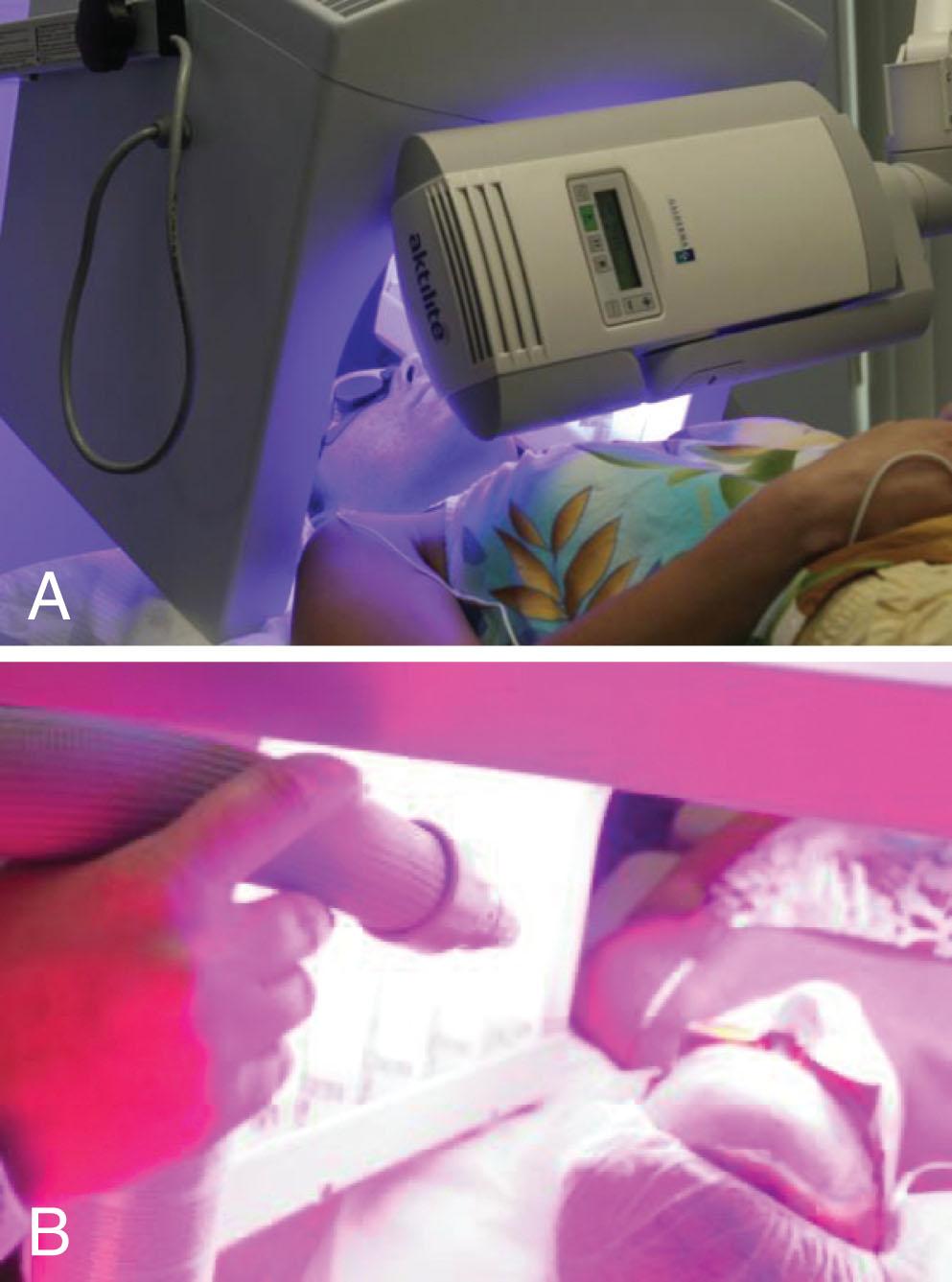
| Pretreatment |
|
|
| Treatment |
|
|
|
|
|
|
|
|
| *C and D often performed simultaneously, with adjuvant forced air cooling | ||
| Posttreatment |
|
|
It is critical for patients to remain indoors from dawn to dusk 36 hours after treatment. Zinc oxide or titanium dioxide sunscreen is applied immediately posttreatment. It should be noted, most UV blocking sunscreens including those with zinc oxide or titanium dioxide will not block visible light unless applied in a thick opaque layer. If patients feel tingling or stinging after treatment, they are most likely being exposed to visible light, usually fluorescent light or sunlight penetrating a window. The most common side effects of PDT are erythema, crusting, itching, and mild edema which typically last about 5–7 days ( Figs. 14.5 and 14.6 ).
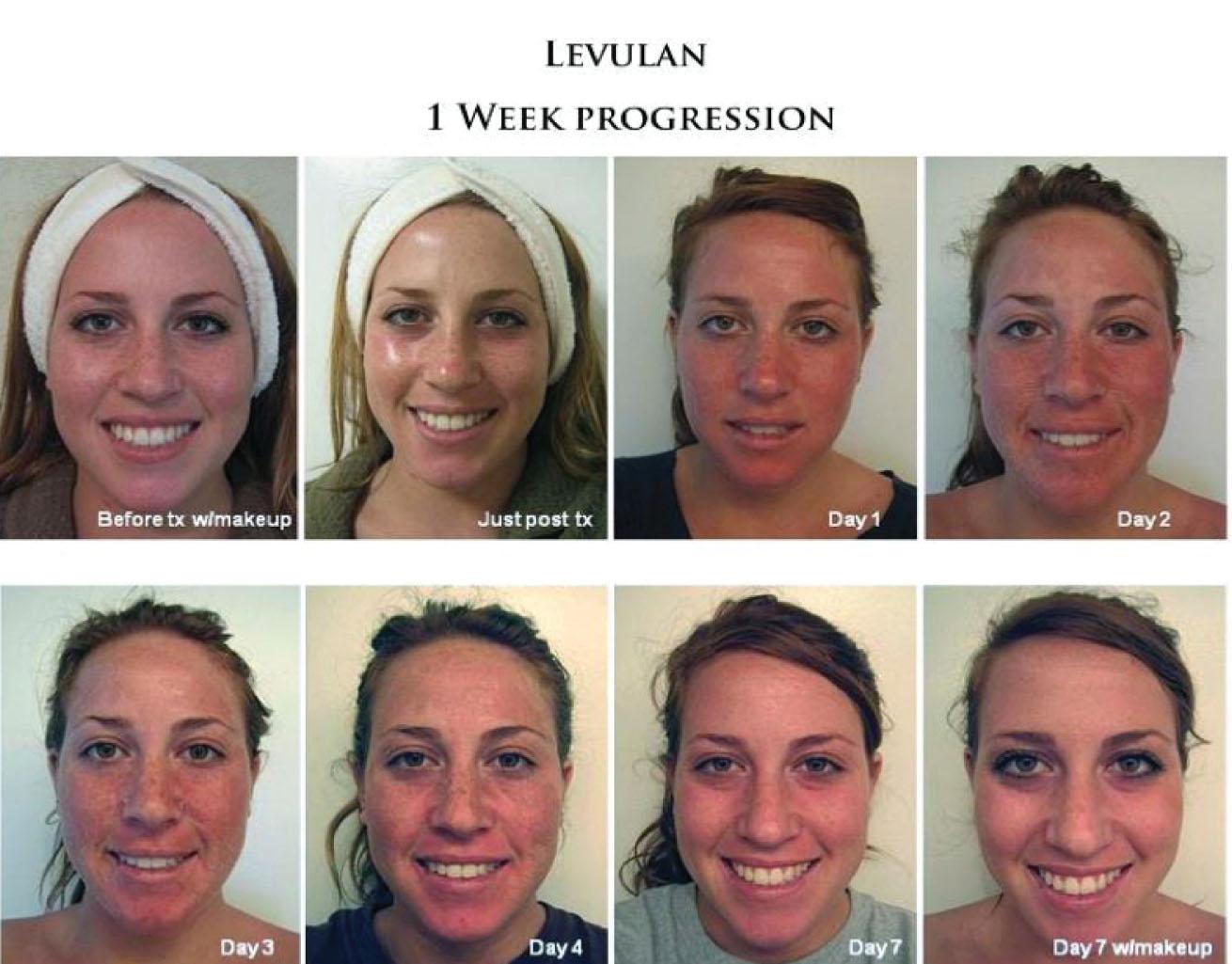
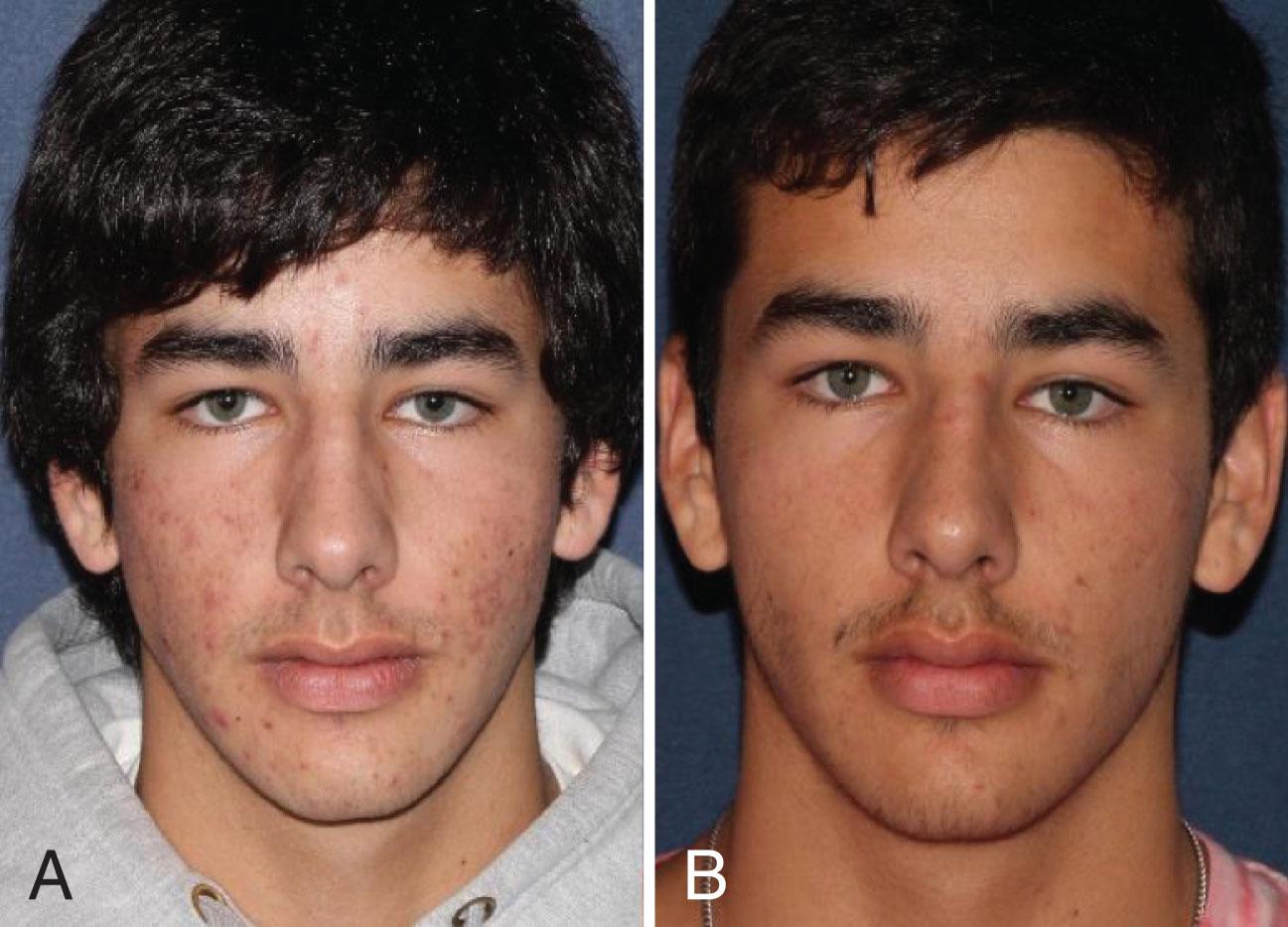
Become a Clinical Tree membership for Full access and enjoy Unlimited articles
If you are a member. Log in here